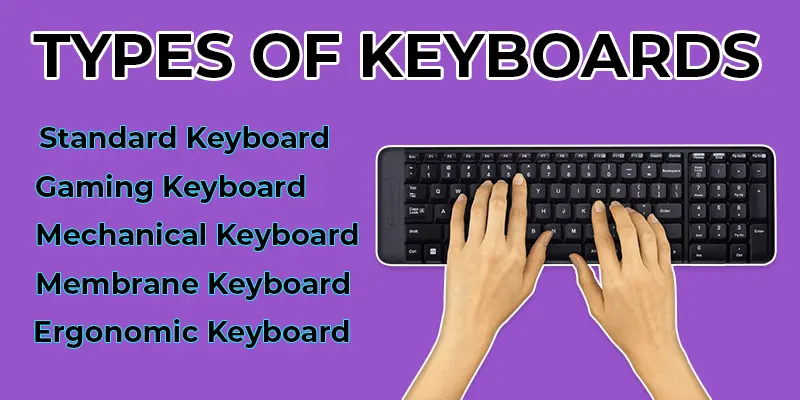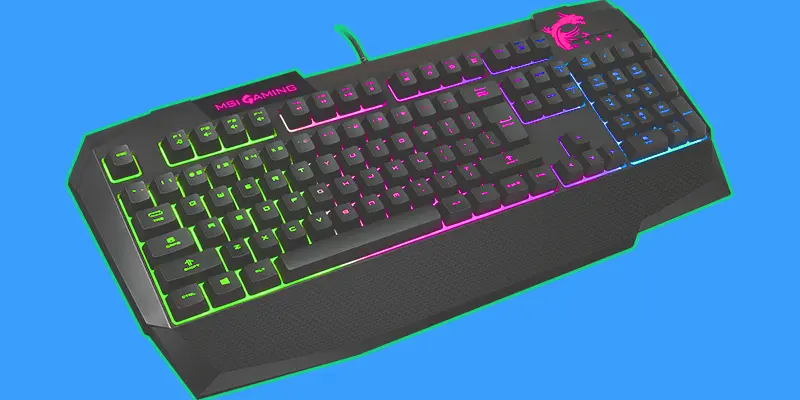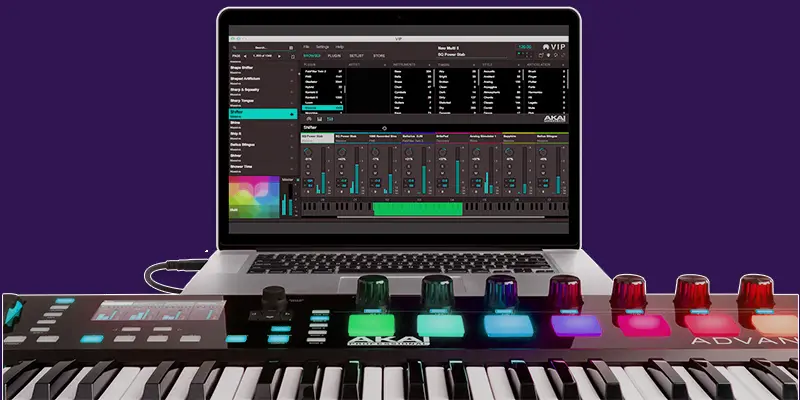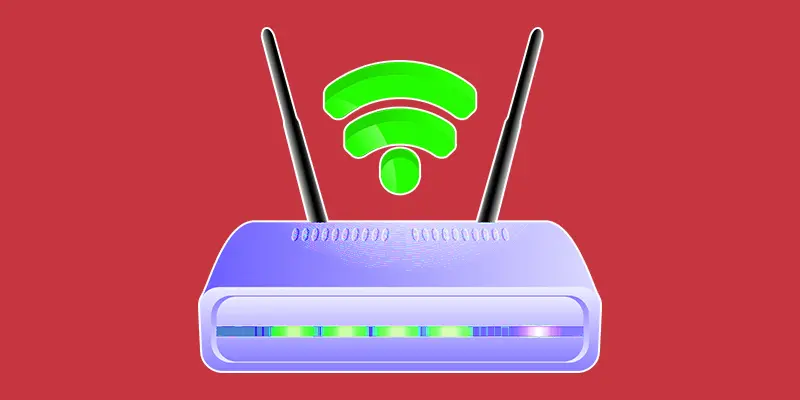Types of Computer Keyboards: Everything You Need to Know
Published: 1 Mar 2024
Types of Keyboard
Computer keyboards come in various types, each designed for specific needs, from casual typing to coding and professional tasks. Have you ever wondered why some keyboards feel different or offer unique features? Choosing the right one can be overwhelming, especially if you’re unsure which type suits your requirements. Whether you’re a gamer, a writer, or just looking for convenience, exploring the different types of keyboards can make all the difference in your productivity and comfort.
Computer Keyboard Types
Computer keyboards come in different types to suit various tasks and preferences. Here are the common types:
- Standard Keyboard
- Gaming Keyboard
- Mechanical Keyboard
- Membrane Keyboard
- Ergonomic Keyboard
- Wireless Keyboard
- Compact Keyboard
- Virtual Keyboard
1. Standard Keyboard
A standard keyboard is the most common type found on most computers. It typically features a layout with alphanumeric keys, function keys, control keys, and special keys like Enter, Backspace, and Spacebar. Standard keyboards can be wired or wireless and are suitable for everyday use.

Alphanumeric Keys
Alphanumeric keys are the keys on a keyboard that represent letters and numbers. They include the 26 letters of the alphabet (A-Z) and the 10 digits (0-9) arranged in a QWERTY pattern.
Keys to Function (F1–F12)
Function keys are found in the upper row of the keyboard and have different functions based on the operating system. They are often used for menu access, etc.
Keys for Navigation
The arrow keys (up, down, left, and right) arranged in an inverted T-shape make up the navigation keys. They work for content navigation on webpages, spreadsheets, documents, and other media.
2. Gaming Keyboard
Gaming keyboards are designed for gamers and often come with features like anti-ghosting technology, customizable key backlighting, programmable macro keys, and mechanical switches for improved responsiveness and durability. They are popular among gamers because they enhance their gaming experience.
Mechanical Switches
Many gaming keyboards use mechanical key switches instead of the rubber dome switches found in standard keyboards. Mechanical switches offer audible clicks and faster response times, providing a more satisfying and precise typing experience. They are also more durable and long-lasting compared to membrane switches.
Customizable Keys
Gaming keyboards often feature customizable keys, allowing users to assign specific functions. This enables gamers to execute complex commands or actions with a single keystroke, enhancing gameplay efficiency.
Backlighting
Most gaming keyboards have programmable backlighting, which improves visibility in low-light environments. Some keyboards also offer maximum per-key RGB lighting.
3. Mechanical Keyboard
Each key on a mechanical keyboard has its mechanical switch. Mechanical keyboards are known for their durability and precision, making them popular among typists, programmers, and gamers.
Mechanical Switches
The defining quality of mechanical keyboards is that they use mechanical switches beneath every keycap. There are many mechanical switches, each with unique features like tactile feedback and audible clicks.
Tactile Feedback
Mechanical keyboards supply tactile feedback, meaning you can feel it when a key push is detected. The tactile feedback feature lets you identify when a key has been pressed.
Durability
Mechanical keyboards are known for their durability. Mechanical ensures that the keyboard can withstand heavy use for many years without experiencing key failures in performance.

4. Membrane Keyboard
Membrane keyboards register key presses using a flexible membrane layer with printed circuit traces. Due to their lower cost, they are commonly found in laptops and budget-friendly keyboards. Membrane keyboards offer a softer keystroke compared to mechanical keyboards.
Membrane Switches
In membrane keyboards, each key is associated with a rubber dome or membrane switch, which compresses when the key is pressed.
Silent Function
They can be used in shared spaces or offices where noise pollution is an issue. The rubber dome switches cushion the impact of key presses, resulting in a soft and muted typing sound compared to mechanical keyboards.
Affordability
Membrane keyboards are often more affordable than mechanical keyboards, making them popular with budget-conscious consumers or organizations seeking cost-effective computer input devices.
5. Ergonomic Keyboard
Ergonomic keyboards lessen strain and discomfort during vast typing sessions by promoting a more natural hand position. By allowing users to place their hands in a more natural shoulder-width posture, this design lessens the pressure on the forearms and wrists.
Split Layout
A split layout keyboard is a type of keyboard where the keys are divided into two separate sections. This layout promotes better ergonomics by allowing the user to position their hands more naturally and comfortably.
Hand Rests
Many ergonomic keyboards include wrist supports to offer additional comfort and support during typing. Palm rests help reduce pressure on the wrists and promote a relaxed posture, further reducing the risk of strain.
Reduced Reach
Certain ergonomic keyboards include a compact design or keys to reduce the need for excessive reaching or stretching while typing. This minimizes strain on the shoulders and upper back, enhancing overall comfort and ergonomic support.
6. Wireless Keyboard
Wireless keyboards connect to computers via Bluetooth or a USB receiver, allowing users to type from a distance without connecting cables. They offer flexibility and mobility. Wireless keyboards come in various designs, including compact and ergonomic models.
Easy Setup
Setting up a wireless keyboard is typically straightforward. Most wireless keyboards come with plug-and-play functionality, meaning you can plug in the USB receiver or pair the keyboard with your device via Bluetooth, and you’re ready to start typing.
Battery-Powered
Wireless keyboards are powered by batteries, which provide the necessary power for the keyboard to function. While this means you’ll need some time to replace or recharge the batteries, modern wireless keyboards often feature energy-efficient designs that can stretch battery life and minimize the need for frequent changes.
Minimal Clutter
Wireless keyboards help decrease cable clutter on your desk or workspace, creating a cleaner and more organized environment. They do not require a physical cable connecting the keyboard to the computer.
7. Compact Keyboard
A compact keyboard is a smaller keyboard that typically features fewer keys than a standard full-sized keyboard. It is designed to save space and be more portable, making it popular for users with limited desk space. Compact keyboards may also have different key layouts compared to standard keyboards, such as keys, to reduce the overall size of the keyboard.
Space-Saving Layout
Despite their reduced size, compact keyboards often retain the most important keys found on full-size keyboards, including alphanumeric, function, and navigation keys.
Portability
One key advantage of compact keyboards is their portability. Their smaller size and lighter weight make them easier to transport and more suitable for laptops, tablets, and other mobile devices.
Smaller Footprint
Compact keyboards are designed to occupy less space on your desk or workspace than full-size ones. They typically have a narrower width and reduced key spacing.
8. Virtual Keyboard
Using a mouse, touchscreen, or other pointing device, users can select on-screen keys to text virtual keyboard, a software-based input device. Virtual keyboards are often used on touchscreen devices like smartphones and tablets as a substitute for physical keyboards. They provide a suitable typing solution when a physical keyboard is not available.
Touchscreen Input
Virtual keyboards are primarily used with touchscreen gadgets like computers, tablets, and smartphones. Instead of physical keys, users interact with the virtual keyboard by tapping or swiping their fingers on the touchscreen display.
Space-Saving
Virtual keyboards stop the need for a physical keyboard, saving space on devices with limited screen real estate or those where space is at a premium.
Security
Virtual keyboards help protect sensitive information from being blocked by malicious software or hardware key loggers.

Conclusion about Types of Computer Keyboards
The size of a computer keyboard can vary depending on the model and design, but a standard full-sized keyboard is usually around 17 to 18 inches wide and 6 to 8 inches deep. The depth of a keyboard, or the distance from the front edge to the back edge, is typically around 5 to 7 inches for a standard full-sized keyboard. Ultimately, your best computer keyboard will depend on your preferences, typing needs, and budget. Explore different keyboard options to find the one that suits your style and enhances your computing experience.
FAQS – Types of the Keyboard
What is the purpose of a computer keyboard?
A computer keyboard communicates between users and computers by allowing them to enter text, commands, and keystrokes.
What is keyboard input and output?
Keyboard input refers to the data entered into a computer system through a keyboard, while keyboard output typically refers to the visual and auditory feedback provided by the computer in response to user input.
What is the size of a computer keyboard?
The size of a computer keyboard can vary, but standard full-size keyboards are typically around 18 inches wide and 7 inches deep. However, compact and mini keyboards with smaller dimensions are also available for space-saving purposes.

- Be Respectful
- Stay Relevant
- Stay Positive
- True Feedback
- Encourage Discussion
- Avoid Spamming
- No Fake News
- Don't Copy-Paste
- No Personal Attacks

- Be Respectful
- Stay Relevant
- Stay Positive
- True Feedback
- Encourage Discussion
- Avoid Spamming
- No Fake News
- Don't Copy-Paste
- No Personal Attacks





